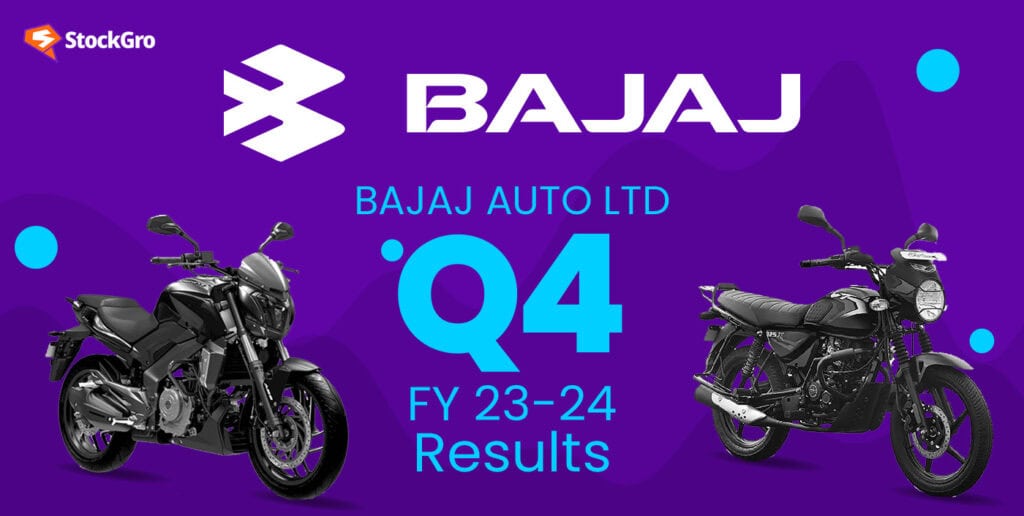
It’s that time of the year again when Bajaj Auto, one of India’s automotive giants, shares its quarterly report card. The company’s Q4 results are finally out, and investors are pouring over the numbers.
As investors closely monitor the Bajaj Auto share price on the NSE, this financial report offers insights into the company’s performance, Bajaj Auto Q4 profit figures, and the pros and cons of investing in BAL.
This quarterly earnings report holds significance not just for the company’s history, but also sheds light on larger industry trends and the brand’s ability to maintain its market dominance.
About Bajaj Auto
Bajaj Auto is the flagship firm of the Bajaj Group, which started its journey in 1945. Based out of Pune, India, the leading manufacturer of two- and three-wheelers exports to 79 nations worldwide.
Bajaj Auto International Holdings BV, a subsidiary of Bajaj Auto Ltd., invested a significant amount of about ₹1,219 crore in the Austrian KTM Group. Later, the well-known British motorcycle manufacturer Triumph Motorcycles and Bajaj Auto Ltd. partnered together.
The company’s stake in the KTM Brand, which makes racing and super sports two-wheelers, has increased from 14% in 2007 to 48% today. On the global stage, it ranks as the third-largest manufacturer of automobiles. Also, when it comes to three-wheelers, it’s the most prominent manufacturer in the world.
To sharpen its emphasis on the electric vehicle market, the parent company has established a wholly owned subsidiary called “Chetak Technology Limited” to handle all aspects of the electric vehicle business, including the development and testing of innovative technologies, innovation in products, manufacturing, advertising, after-sales, and customer-driven services.
Bajaj Auto Ltd. has achieved a market capitalisation of ₹1 trillion, a remarkable milestone in its history. This accomplishment solidifies its position as the most well-known two- and three-wheeler company in the world.
Also read: Lic Q3 Results 2023
Bajaj Auto Q4 results: Quarterly performance
In Q4 of FY24, Bajaj Auto Ltd. announced a consolidated net profit of ₹2,011.43 crore. In the quarter ending March 31, 2024, the organisation reported a consolidated revenue of ₹11,554.95 crore.
The domestic motorcycle market continued its robust expansion, with the 125+ cc category driving growth of two times the market share. The board of directors also decided to pay a dividend for the fiscal year ending March 31, 2024, of ₹80 per share.
That said, for fiscal year 2024, let’s look at the shift from quarter to quarter.
| CONSOLIDATED RESULTS | JUN ’23 – Q1 | Sept ‘23- Q2 | Dec ‘23- Q3 | Mar ‘23- Q4 |
| Net sales (₹ cr.) | 10,055.51 | 10,838.24 | 12,165.33 | 11,554.95 |
| Net Profit (₹ Cr.) | 1,644.14 | 1,836.40 | 2,032.62 | 2,011.43 |
| EBITDA (₹ Cr.) | 2,300.26 | 2,494.20 | 2,775.98 | 2,307 |
Source: Moneycontrol
A snapshot of expectations vs reality
According to the average predictions of five brokerages, Bajaj Auto was expected to bring in a net profit of ₹1,805 crore in the fourth quarter.
Predictions showed that the company’s revenue for the quarter ending in March 2024 would increase by about 26% to ₹11,200 crore, up from ₹8,904.7 crore in the same quarter last year.
Let’s see how Bajaj Auto performed in Q4 FY24 compared to the analysts’ predictions.
| Q4 FY24 | Analysts’ predictions | Actual figures |
| Net profit (₹ crores) | 1,805 | 2,011.43 |
| Revenue (₹ crores) | 11,200 | 11,554.95 |
| EBITDA margin (%) | 19.85 | 20.1 |
Also read: Zomato Q3 results
Current financials As on 18 April, 2024
| Metric | Value |
| Market cap (₹ Cr.) | 255,464 |
| Book value per share (₹) | 1,036.86 |
| Dividend Yield | 1.55 |
| ROCE | 26.2 % |
| ROE | 20.63% |
| TTM PE | 34.52 |
Financial summary: FY24 growth over FY23
| Particulars | FY24 | FY23 | Change |
| Turnover (₹ crore) | 46,088 | 37,609 | 23% |
| Revenue from operations (₹ crore) | 44,685 | 36,428 | 23% |
| EBITDA (₹ crore) | 8,825 | 6,551 | 35% |
| EBITDA % | 19.7% | 18.0% | +180 bps |
| Profit before tax (₹ crore) | 9,822 | 7,409 | 33% |
| Profit after tax (₹ crore) | 7,479 | 5,628 | 33% |
Competitor information of Bajaj Auto
| TTM PE | Market cap(₹ crores) | ROE | Net profit in Q3 2024(₹ crores) | |
| TVS Motor Company Ltd. | 61.83 | 101,093 | 24.13 | 510 |
| Hero Motocorp | 25.44 | 91,964.00 | 16.87 | 1,091 |
| Wardwizard Innovations and Mobility Ltd. | 148.59 | 1,694.76 | 10.63 | 5.70 |
| Atul Auto | 196.40 | 1,401.16 | 1.14 | 4.47 |
Shareholding pattern of Bajaj Auto
The shareholding pattern (as of December 2023) of Bajaj Auto is as follows:
| Promoters | 54.94% |
| Foreign Institutional Investors (FIIs) | 14.64% |
| Domestic Institutional Investors (DIIs) | 8.73% |
| Public | 21.67% |
Also read: Zomato-q3-results
Investing in Bajaj Auto
Pros
- Diverse two-wheeler portfolio
The company’s Q4 and FY results were driven by robust demand for its motorcycles within the country and an upsurge in the export of two-wheelers. Domestic motorcycles continued their dominant performance in the 125cc+ segment.
Because of the solid product development skills, well-established brand, diverse product range, and dominant market position, it is expected that the performance may stay consistent. After Q4 FY24, Bajaj Chetak delivered the highest quarterly volume, securing the third position in the electric two-wheelers market.
- Three-wheeler and commercial vehicles market leader
Commercial vehicles continue to dominate, setting new records for volume as the 2024 fiscal year comes to an end. Year-over-year growth exceeds 50%, putting them ahead of the competition. For the first time, Bajaj’s market share reached about 80% due to its well-known ‘RE’ and ‘Maxima’ models.
In the past, the corporation had acquired nearly 67 per cent of the local three-wheeler market as of December 2023. This made them the undisputed leader in the industry.
Electric three-wheelers from BAL have been well-received in places like Agra and Delhi. This segment’s consistent cash flow offers a solid foundation for the company’s risk profile and revenue variety.
- Strong financial profile
With a strong 23% year-on-year growth, Bajaj Auto reached a record-breaking revenue of ₹44,685 crores in FY24. Vehicles and spare part sales were the engines that drove this incredible expansion, alongside the highest ever EBITDA of ₹8,825 crores, growing a solid 35% YoY.
With about ₹6,600 crores of free cash flow contributed this year—a significant 45% YoY growth—the company maintained an impressive cash generation track record. Bajaj Auto’s balance sheet remained stable, boasting surplus funds of ₹16,386 crores as of March-end.
Cons
- Profitability and economic sensitivity
The stresses from price inflation and a slowing economy are causing macroeconomic challenges, which the automotive sector is struggling to overcome. Slowing economic activity may affect sales because consumers cut back on purchasing non-essential goods when the economy is in a downturn.
However, BAL has implemented minor price adjustments to reflect the reduced cost of commodities.
- Competitive Market Exposure
There is a lot of competition in the Indian two-wheeler industry from companies like TVS Motors Ltd., Hero Motocorp, and others. As a result of their innovative products and varied offerings, BAL has maintained a respectable portion of the market.
Conclusion
The Bajaj Auto Q4 results solidify Bajaj Auto’s position as a front-runner in the Indian automotive sector. However, the road ahead is paved with stiff competition and evolving consumer demands.
Adapting to these changes while capitalising on the brand’s strengths will be vital for sustaining its Bajaj Auto share price growth trajectory.

